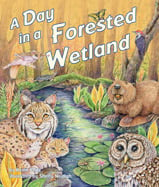Alignment to Standards for SC

| Grade | Number | Standard |
|---|---|---|
| 1 | SC:1-2.5 | distinct environments throughout the world support the life of different types of plants. |
| 2 | SC:2-2.1 | Recall the basic needs of animals (including air, water, food, and shelter) for energy, growth, and protection. |
| 2 | SC:2-2.3 | distinct environments throughout the world support the life of different types of animals. |
| 2 | SC:2-2.4 | Summarize the interdependence between animals and plants as sources of food and shelter. |
| 3 | SC:3-2.2 | Explain how physical and behavioral adaptations allow organisms to survive (including hibernation, defense, locomotion, movement, food obtainment, and camouflage for animals and seed dispersal, color, and response to light for plants). |
| 3 | SC:3-2.3 | Recall the characteristics of an organisms habitat that allow the organism to survive there. |
| 3 | SC:3-2.4 | Explain how changes in the habitats of plants and animals affect their survival. |
| 3 | SC:3-3.5 | Illustrate Earths saltwater and freshwater features (including oceans, seas, rivers, lakes, ponds, streams, and glaciers). |
| 3 | SC:3-3.6 | Illustrate Earths land features (including volcanoes, mountains, valleys, canyons, caverns, and islands) by using models, pictures, diagrams, and maps. |
| 3 | SC:3-3.8 | Illustrate changes in Earths surface that are due to slow processes (including weathering, erosion, and deposition) and changes that are due to rapid processes (including landslides, volcanic eruptions, floods, and earthquakes). |
| 4 | SC:4-2.1 | Classify organisms into major groups (including plants or animals, flowering or nonflowering plants, and vertebrates [fish, amphibians, reptiles, birds, and mammals] or invertebrates) according to their physical characteristics. |
| 4 | SC:4-2.2 | the characteristics of distinct environments (including swamps, rivers and streams, tropical rain forests, deserts, and the polar regions) influence the variety of organisms in each. |
| 4 | SC:4-2.5 | Explain how an organisms patterns of behavior are related to its environment (including the kinds and the number of other organisms present, the availability of food and other resources, and the physical characteristics of the environment). |
| 4 | SC:4-2.6 | Explain how organisms cause changes in their environment. |
| 5 | SC:5-2.2 | composition of an ecosystem, considering both biotic factors (including populations to the level of microorganisms and communities) and abiotic factors. |
| 5 | SC:5-2.3 | characteristics of different ecosystems (including estuaries/salt marshes, oceans, lakes and ponds, forests, and grasslands). |
| 5 | SC:5-3.1 | natural processes (including weathering, erosion, deposition, landslides, volcanic eruptions, earthquakes, and floods) affect Earths oceans and land in constructive and destructive ways. |
| 5 | SC:5-3.3 | Compare continental and oceanic landforms. |
| K | SC:K-2.1 | Recognize what organisms need to stay alive (including air, water, food, and shelter). |
| K | SC:K-2.2 | Identify examples of organisms and nonliving things. |
| K | SS:K-5.4 | Recognize natural features of the environment, including mountains and bodies of water, through pictures, literature, and models. |